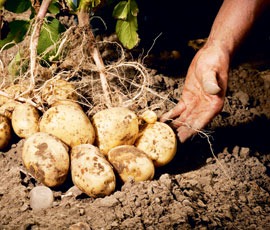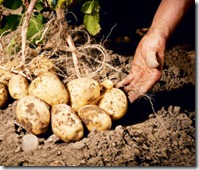Monitoring crop quality through selective sample digs can reassure customers about quality and help inform harvesting decisions. Philip Case investigates.
Regular sample digs of potatoes before harvest are an essential tool to help understand potential crop yield and quality, according to independent potato agronomist John Sarup.
"Potato growers should be encouraged to carry out plenty of digs before they start to harvest crops and their importance should not be underestimated," he says.
Digs can give an early indication of whether crops are likely to meet customer specifications, he adds.
Mr Sarup, director of SPUD Agronomy & Consultancy, recommends carrying out digs at least every fortnight, increasing to a weekly basis as the decision to burn off the crop nears.
"Growers need to carry out as many digs as necessary to make sure that it is representative of the whole field," he suggests.
To achieve a good assessment of tuber count, growers should concentrate their digs in areas that can convert easily into yield, he says.
"For example, you can dig two 3m row lengths, whereas the more traditional grower may want to try a 6ft dig and weigh the results in pounds, which roughly equates to tonnes/acre."
For packing crops, growers should be looking at soil moisture, assessing tubers for quality, including skin blemishes, greening and potential disease inoculum, such as bacterial rots, black dot and black scurf.
For processing crops, tuber count and size, dry matter, and noting any presence of bacterial rots such as blackleg are key indicators.
The information gleaned from digs can be used to update customers about crop quality to help harvesting decisions.
The digs may also contribute year on year towards helping decision-making in the future.
Three areas are important when carrying out sample digs: tuber size/number, quality, and harvest.
TUBER NUMBER/SIZE
Harvest aim For tuber number and size, the aim is to meet customer specifications. For example, tubers for a salad crop ideally need to be less than 42mm. However, for a processing crop, such as Markies grown for McCain, tubers should be more than 90mm in length to meet the desired specification for chips, while the tuber count ideally needs to be below 67 tubers in a 10kg sample.
What to look for in a sample In the assessment, the relationship between tuber number and stem number is important. For processing crops, the bigger the number of stems and tubers, the longer it may take for the crop to bulk up to the required size.
How to use the assessment Many processing crops, including Markies, continue to produce foliage and tubers throughout their life. But foliar sprays of maleic hydrazide can inhibit plant growth and allow plants to concentrate their energy on bulking up existing tubers that will achieve marketable size.
For packing crops, maleic hydrazide can only be applied under certain circumstances. A derogation is required from the customer to apply it to certain varieties, including King Edward, to help prevent sprouting in store.
QUALITY
Harvest aim Potato crops need to meet customer quality needs and the digs provide crop intelligence, which ultimately affect product grade. If certain potato crops are not meeting specifications, growers can work with the customer to maximise the use of that crop in a different grade of potato product.
What to look for in a sample For processing crops, check that tuber numbers and size meet specifications. Keep an eye on dry matter, greening, misshapen tubers, secondary growth, bacterial rots, cankerous powdery scab, or internal defects such as spraing (tobacco rattle virus spread by free-living nematodes).
For packing crops, check for greening, skin blemishes, internal defects, soft rots and diseases such as common scab, black scurf and black dot.
How to use the assessment The digs dictate how to take the crop on to harvest. Crops with tubers showing defects – for example, more than 5% damage due to a specific disease, such as bacterial rots – may fall below specifications. In general, end users do not want crops showing more than 15% wastage.
For example, a crop with a large amount of soft rots would require more care when handling as there is a greater chance of spreading the bacteria.
Later-lifted crops have an increased risk of being harvested in poor conditions whereby there may be a lot of soil stuck to tubers making the crop difficult to dry. This is where the importance of achieving good skin set comes in.
HARVEST DATE
Harvest aim The aim is to get the crop harvested in good condition so that it stores well and gets delivered to the customer in good order. Most growers will have a harvest date in mind, which could be influenced by the weather, frost risk, or choice of following crop.
What to look for in a sample Regular digs can help monitor crops, including tuber size and dry matter. If the crop is meeting customer specifications, consider desiccation. Bear in mind that crops with large canopies, such as Markies, will take longer to kill compared with crops that are already senescing. And depending on variety, crops can take four weeks or more to achieve skin set.
How to use the assessment Work out how many hectares of potatoes can be harvested in a day and use this information to calculate your harvest start date and when you will need to start burning off crops.
During digs, if it is clear the crop is not going to achieve its full potential, it is important to communicate with the customer over any changes to harvest date.
It may be necessary to call in a contractor at the start of harvest and get the crop out of the ground earlier.


Deprecated: strpos(): Passing null to parameter #1 ($haystack) of type string is deprecated in /home/agriviek8Qv/agriviet.net/public_html/wp-includes/comment-template.php on line 2522